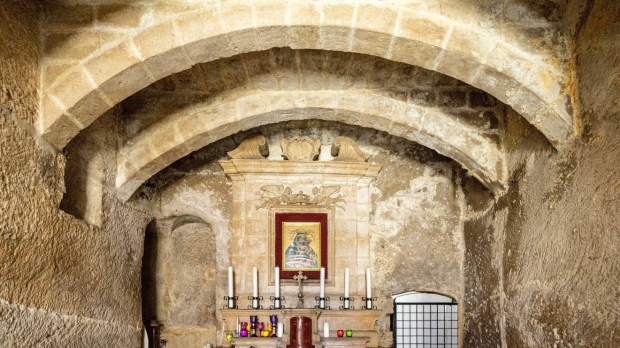From prehistoric cave dwellings and burial chambers to medieval and modern military tunnels, the history of Malta is deeply intertwined with its relatively “soft” rock formations and its limestone caves. Early Christians turned caves and pre-existing catacombs into chapels that could accommodate a growing community of believers, resulting in a series of churches that appear to have formed naturally out of the beautiful Maltese underground landscape.
As explained by Dr. Charlene Vella to the website Guidememalta.com, (the Department of Art and Art History at the University of Malta), cave churches also took a symbolic meaning as they were seen as a “prefiguration of the Entombment and Resurrection” of Jesus Christ.
Known as troglodyte churches, from the Greek word τρωγλοδύτης (troglodýtis) trogle–dyein (trogle: “hole” or “cave” and dyein: “get into”), cave churches are one of the most interesting architectural developments in the history of Christian culture. While other cave churches have appeared across the Mediterranean, fromSouthern Italy toFrance, Maltese cave churches are unique for the quality of their finely decorated interiors, featuring limestone carvings and colorful murals.
Often, it was hermit-monks who discovered suitable natural enclaves for prayer and meditation which were later used by Christians as places of worship. Sometimes, when local parish communities experienced fast growth, cave churches were annexed to existing catacombs built by the early Christian community way back when Christian burials were not allowed within the city walls.
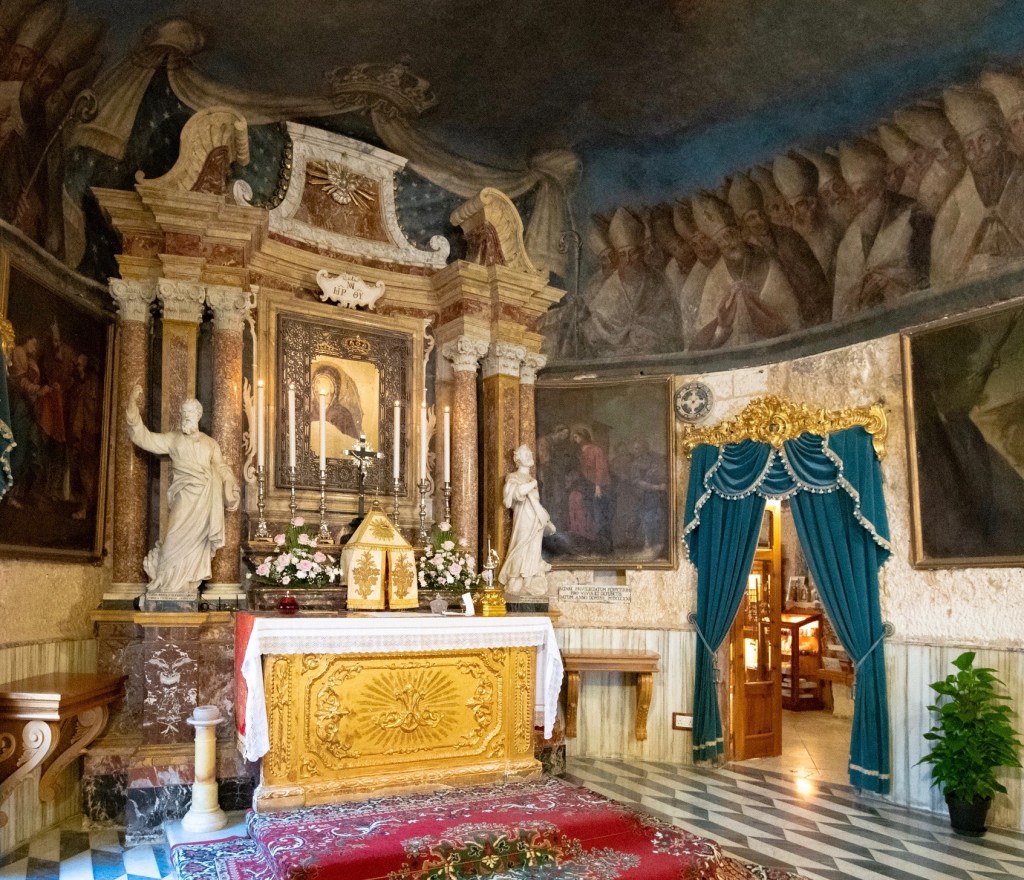
In the Maltese Islands there are several cave churches. Our rock formations are mostly of globigerina limestone, soft and easy to burrow, and caves and caverns are common in such geological environment. Certainly, apart from the many we already know about, there are many more yet to be discovered. To unearth or discover some of these is a long and arduous task.
The cave church of Msida
The troglodyte church of the Immaculate Conception of Msida dates back a very long time. In fact, the origin of the church is not known. In the old days, the church did not have juspatronage and depended on the Bishop. From Bishop Senatore de Mello’s Rollo of 1436 (an inventory of parishes in Malta), it transpires that it was part of the parish of Birkirkara. With this, it is confirmed that this church already existed at that early time. This church was also officially mentioned by Mgr. Pietro Duzina’s Apostolic visit, in 1575. At the time this church was dedicated to Our Lady of Perpetual Help. During the 13th and 14th centuries the Auxilium Christianorum, Madonna del Soccorso, Our Lady of Rescue, Our Lady Help of Christians devotions were very popular.
Pastoral Visits
For hundreds of years, it seems that this church had no one living around it, but had many devotees from the nearby villages, and many women who used a nearby natural spring and well to do their domestic cleaning. All these devotees would go to the cave church to pray to the Holy Mother. In his 1575 visit Duzina reported that this church was in a bad state, and the paintings and other artefacts it contained were broken and torn, but he did not want to close it without giving a try to save it. He gave eight days’ time to find the necessary means and benefactors to restore it, and should this not happen the church would be desecrated and closed. However, it is not known whether it was actually closed or not.
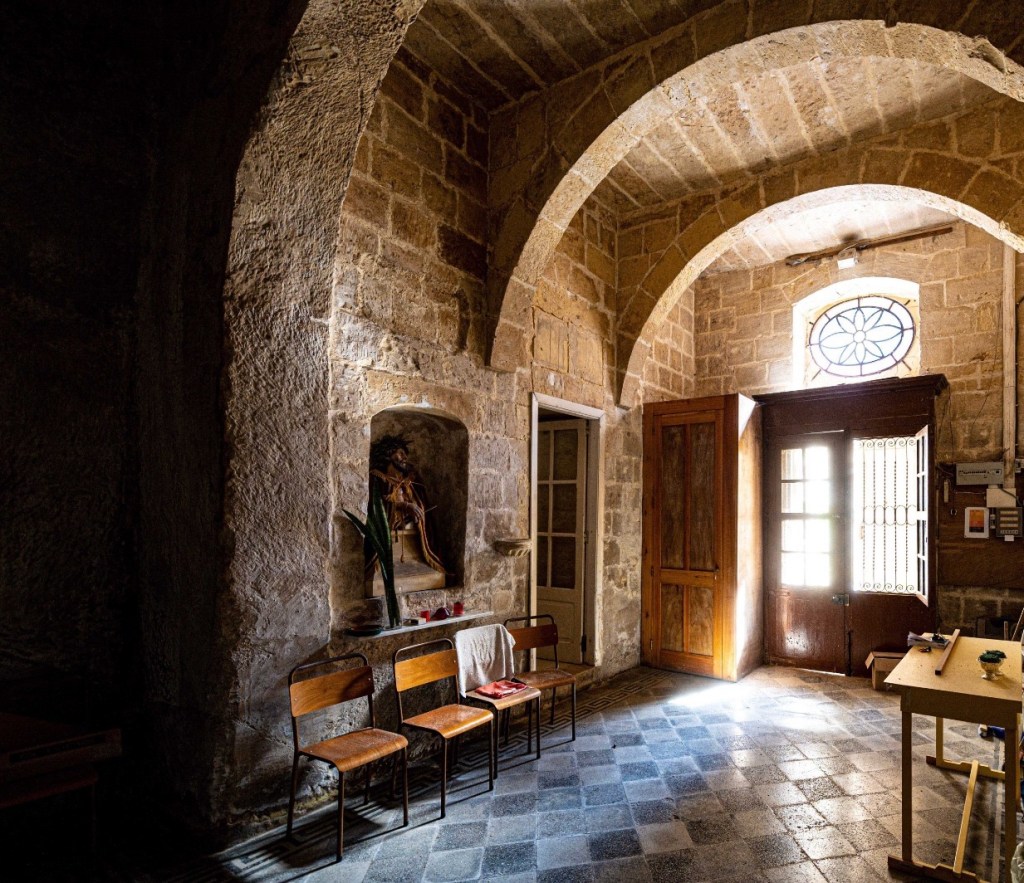
In a report of another pastoral visit, in 1615, by Bishop Baldassare Cagliares, it seems that the dedication was changed from Our Lady of Perpetual Help to the Assumption, the title by which the Blessed Virgin Mary is the Patroness of the Archipelago. In 1637, Bishop Michele Giovanni Balaguer de Camarasa reported that the church was functioning well, had an adjacent cemetery and housed a beautiful image of the Madonna. According to Achille Ferris, who in 1866 wrote the history of the Churches of Malta and Gozo, the church was rebuilt in 1640.
In another report by Bishop Balaguer (compiled between 1656 and 1659), we find that the church was referred to, for the first time, as the Church of the Glorious Immaculate Conception of Our Lady.
Devotion to the Immaculate Conception
The devotion to the Immaculate Conception in the Maltese Islands considerably predates the respective Dogma of Faith. Although the dogma on the Immaculate Conception of Our Lady was promulgated in 1854, by Pope Pius IX, the devotion to Our Lady under this title originates from early Byzantine times. Indeed, the works of the early Fathers of the Church clearly show that it was widely understood and accepted, as from the beginning of Christianity, that Maryam of Nazareth – the Theotokos – was immaculately conceived.
For instance, in his Gospel, Saint Luke says that the angel proclaimed, “Hail Mary, full of grace…..” Also, in his impassioned statements, Saint Ephrem (c. AD 306-373) pronounced the Mother of God as:
“Full of grace . . . all pure, all immaculate, wholly without sin, wholly without stain, wholly without reproach . . . virgin in soul, in body, in spirit.” and “Only you [Jesus] and your Mother are more beautiful than everything. For on you, O Lord, there is no mark; Neither is there any stain in your Mother.”
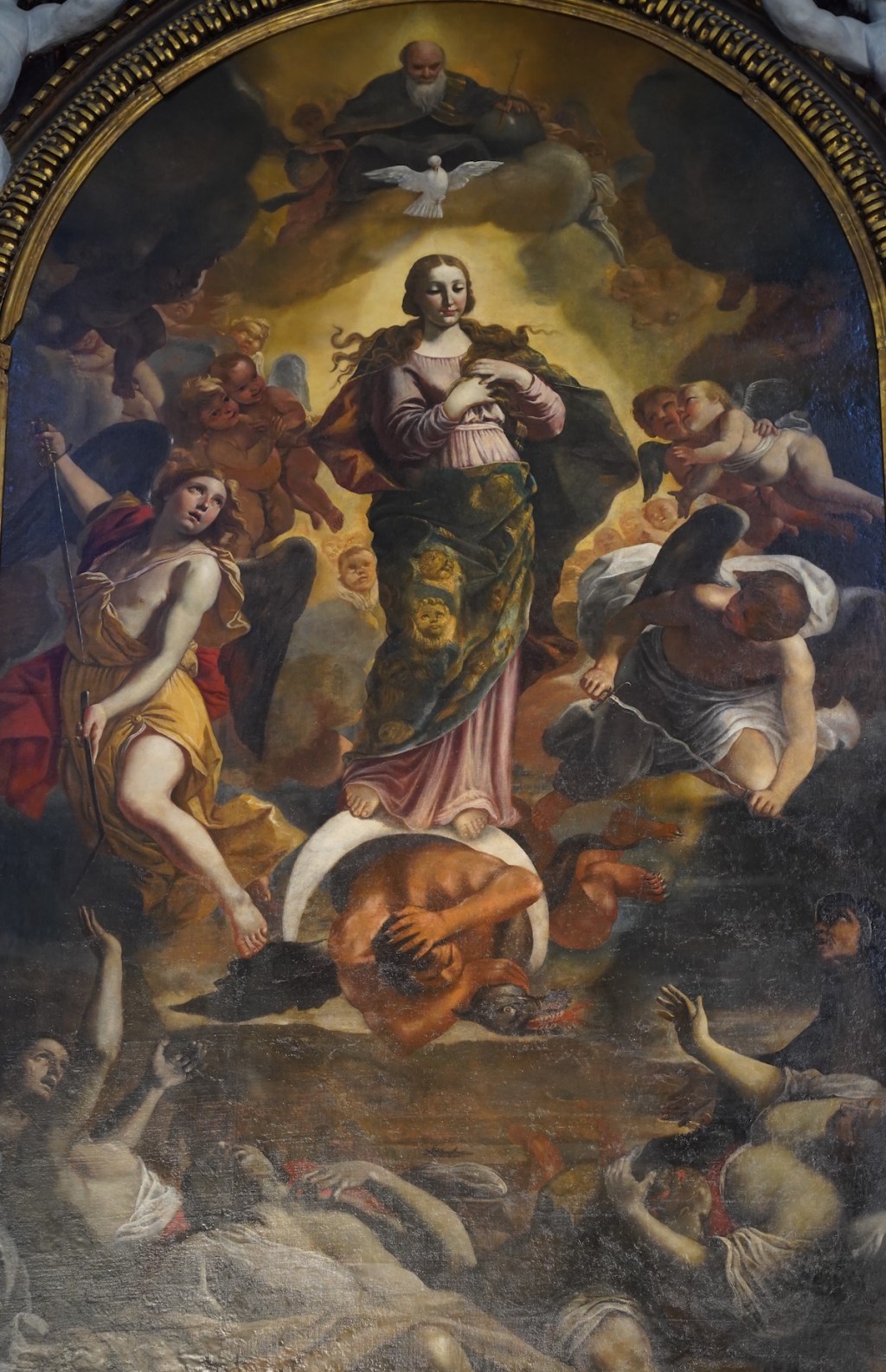
Saint Gregory Nazianzus (c. AD 329 – 390) called Mary Prokatharthesia which means ‘purified before.’ It is most probable that the Maltese embraced the title of Immaculate Conception since those early times. Malta is surely one of those countries where Our Lady was recognized as the Immaculate Conception.
Of graces and benefactors
Unfortunately, like other churches hewn in rock, the cave church in Msida did not escape damages caused by the elements and had to be repaired and restored several times. But Providence never failed to intervene. Indeed, great benefactors such as the Famucelli family and Fra Philip Wolfgang, Baron of Guttenberg and Bali of Brandenburg (Balliju, as they referred to him at that time) stood out and contributed heavily to the upkeep of this church. Guttenberg was a benefactor of many churches in Malta. These benefactors also adorned it with great works, some of which unfortunately disappeared.
The Bali, furnished this church with all necessary things. He also donated money for a legacy to celebrate Holy Masses in perpetuity. A tablet in Latin affixed to a wall in the church commemorates this legacy. In English it reads as follows:
“The illustrious Sir Filippu Wolfgangus, Baron of Guttenberg, Bali of Brandenburg, of the Order of St. John, to increase even more the cult towards God and his Virgin Mother and for the benefit of the people who visit, wanted that in this church every year a Mass is celebrated on Sundays and on the feast days of obligation, by establishing a perpetual foundation with a dowry in the acts of the Notary Ġużeppi Callus on the 30th of September of the year 1731.”
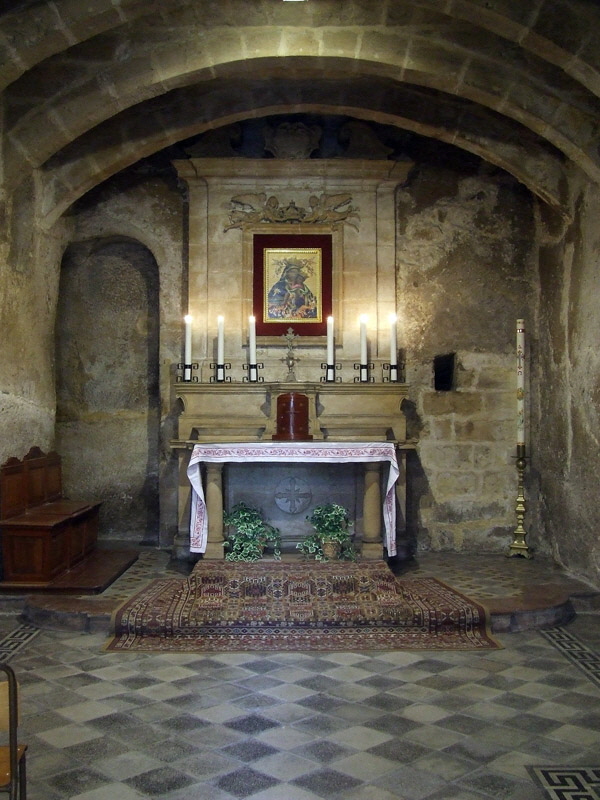
He contributed so much to this Church that for a while the people referred to it as “The Church of Bali.” It also seems that among the many houses he had, Guttenberg had a house right next to it.
Saved by love, devotion, and providence
In the 19th century the marked increase in Msida’s population rendered the church of the Immaculate Conception too small for the growing pastoral needs. At that time Msida was still part of the parish of Sant’ Elena in Birkirkara, which had a vast jurisdiction. This made it somewhat difficult to properly serve the people in the exercise of the sacraments. In Achille Ferris’ work, referred to before, we find that in 1835 the Birkirkara filial Church of the Immaculate Conception, was elevated to a Vice parish to serve those who lived in Msida. In 1851, the need was felt to enlarge this church since its limited space did not cater well for the people of Msida.
However, enlargement wasn’t possible since the church was hewn in rock. Therefore, it was decided that while keeping and preserving this church, plans to build a larger church would commence. Nonetheless, in 1859 a way to extend the church was found – the adjacent sacristy was transformed into a chapel dedicated to Our Lady of Mount Carmel, and a new sacristy was built. However, in 1867, Msida was elevated to a separate parish, with the Church of the Immaculate Conception as its parish church, but a few years later, the present Msida parish church dedicated to Saint Joseph was built.
The humidity affliction, mainly coming from rock formations at the rear of the church, persisted and continued to cause great damage. In fact, in 1907, a pastoral visit of Bishop Pietru Pace, resulted in the closing down of the church, due to the bad state he found it in. He ordered that it was to open again, once satisfactory exterior and interior restoration works were completed. These took too long to commence and the damage increased. In 1911, it was also condemned by both the Civil and Ecclesiastical Authorities. The church was closed down for years and the people began to complain and to pray fervently for their beloved spiritual home, to be repaired and reopened, but few were the offerings to get the work done, and the church was almost lost forever.
Then Providence struck! In 1916, Auxiliary Bishop, Fr. Angelo Portelli, arrived just in time. He worked unceasingly and heartily to save the church of the Blessed Virgin Mary. Fr. Angelo also made an appeal in a local newspaper, headlined “An Appeal to Good Hearts” (Talba lill-Qlub Tajba). In this notice the Bishop stated that the Sanctuary of Our Lady of the Immaculate Conception was in a very bad state and pleaded for help. He offered himself as guarantor for all that was collected and overseer of how it was spent.
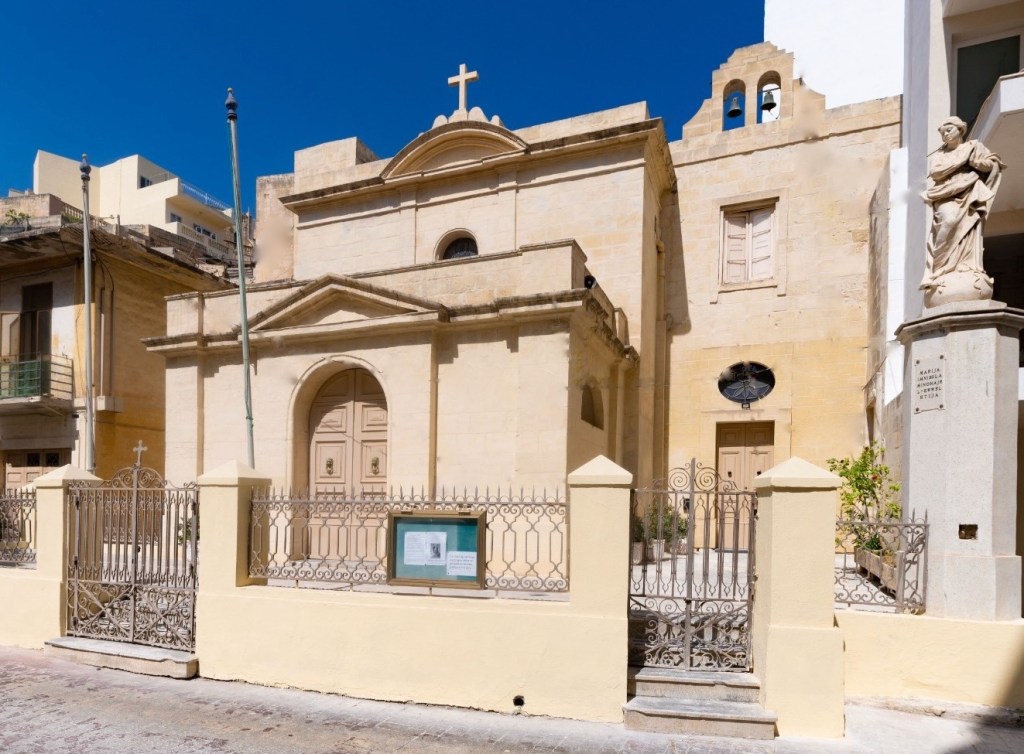
The hearts of the Maltese came to the rescue. They could not watch the sanctuary go to ruins. Generous offers from every corner of Malta flowed in. All the work was done, and done very well, indeed the sanctuary also got new paving. There was rejoicing among the people, as the church was in everyone’s heart. The accounts kept by the parish procurator show that after this ordeal the church needed, and still does, continuous preservation works.
Final thought
We have seen that the origins of the Church of the Immaculate Conception in Msida are lost in time, and many were the times when it was on the edge of the precipice. But Our Lady kept her sanctuary under her mantle, and sent “angels” at the right time, such as the Famucelli family, the Bali of Brandenburg Fra Philip Wolfgang, Bishop Angelo and the list goes on. But we cannot fail to mention the great devotion of the people and the great love they showed when this church was in need. The Maltese poured out their hearts to preserve the Blessed Mother’s home and their home, as was done in many other churches. Today, the faithful call this cave church “the little church” (il-knisja ż-żgħira).
References
Busuttil R. Il-Kappella tal-Kunċizzjoni – Msida (The Chapel of the Immaculate Conception – Msida). Kappelli Maltin (Maltese Chapels)
Calleja J. L-Imsida il-Bieraħ u Llum – Vol. 1 Il-Ħajja Reliġjuża Ta’ Raħal (Msida Yesterday and Today – Vol. 1 The Religious Life of a Village). Malta. 1989
Gambero L. “Mary and the Fathers of the Church”. Translated by Thomas Buffer. Ignatius Press. 1999
Terribile T. Teżori fil-Knejjes Maltin – L-Imsida (Treasures in Maltese Churches – Msida). Malta. 2009
